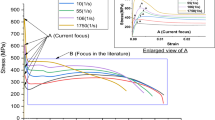Abstract
As dislocation emission is regarded as the critical point of brittle-to-ductile transition of fracture mechanism and the defects interact with domain walls motions due to their self-stress fields, the investigations on dislocation forces, especially the interaction force and the reaction between domain switching and dislocations, are the most important fundamentals of dislocation slip in the brittle-to-ductile transition and the pinning effect on domain wall motion mechanisms. In this paper, an innovative method base on the strain nucleus simulated by an assembly of four dislocations and the Green’s function integration is used to solve generalized stress field arising from domain switching. Then, the accurate expressions of the interaction forces, pinning forces and the image forces on dislocation are obtained and analyzed. At last, the lattice resistance is also discussed. The numerical results show that the dislocation emission is possible when temperature and load are proper, and the domain switching interaction force is the main driving force of dislocation slip in ferroelectric material under negative electric field load. The curve and equation of the lattice resistance correlated with temperature can also be fitted by the results of the proposed analytical method and corresponding experiments.
Similar content being viewed by others
References
Beltz, G.E. and Rice, J.R. (1992). Dislocation nucleation at metal/ceramic interfaces. Acta Metallurgica et Materialia 40, S321-S331.
Beom H.G., Atluri S.N. (2003) Effect of electric fields on fracture behavior of ferroelectric ceramics. Journal of the Mechanics and Physics of Solids 51: 1107–1125
Chen B. J., Liew K. M., Xiao Z.M. (2005) A dislocation interacts with a finite crack in piezoelectric media. International Journal of Engineering Science 43: 1206–1222
Chung M.Y., Ting T.C.T. (1996) Piezoelectric solid with an elliptic inclusion or hole. International Journal of Solids and Structures 33: 3343–3461
Damjanovic D. (1998) Ferroelectric, dielectric and piezoelectric properties of ferroelectric thin films and ceramics. Reports on Progress in Physics 61: 1267–1324
Friedel, J. (1980). Dislocations. Beijing Science Press.
Feng H., Fang Q.H., Zhang L.C., Liu Y.W. (2013) Effect of cooperative grain boundary sliding and migration on emission of dislocations from a crack tip in nanocrystalline materials. Mechanics of Materials 61: 39–48
Gao, P., Nelson, C.T., Jokisaari, J.R., Baek, S.H., Bark, C.W., Zhang, Y., Wang, E., Schlom, E. G., Eom, C.B. and Pan, X. (2011). Revealing the role of defects in ferroelectric switching with atomic resolution. Nature Communications 2, 591.
Hartmaier A. (2005) Thermal activation of crack-tip plasticity: The brittle or ductile response of a stationary crack loaded to failure. Physical Review B 71: 024108
Hirth, J.P., Lothe, J. (1964). Theory of dislocations, second ed. New York John-wiley.
Hwang S.C., Lynch C.S., Mcmeeking R. M. (1995) Ferroelectric/ferroelastic interactions and a polarization switching model. Acta Metallurgica et Materialia 43: 2073–2084
Liu D., Chelf M., White K.W. (2006) Indentation plasticity of barium titanate single crystals: Dislocation influence on ferroelectric domain walls. Acta Materialia 54: 4525–4531
Ma L.F. (2011) Fundamental formulation for transformation toughening. International Journal of Solids and Structures 47: 3214–3220
Pak Y.E. (1990) Crack extension force in a piezoelectric material. ASME Journal of Applied Mechanics 57: 863–869
Rice J.R., Thomson R. (1974) Ductile versus brittle behavior of crystals. Philosophical Magazin 29: 73–97
Rice J.R. (1972) Some remarks on elastic crack-tip stress fields. International Journal of Solids and Structures 8: 751–758
Schaller R. (2000) Mechanical spectroscopy of the high-temperature brittle-to-ductile transition in ceramics and cermets. Journal of Alloys and Compounds 310: 7–15
Sen D.P.J., Thaulow C., Schieffer S.V. (2010) Atomistic study of crack tip cleavage to dislocation emission transition in silicon single crystals. Physical Review Letter 104: 234402
Sosa H. (1991) Plane problems in piezoelectric media with defects. International Journal of Solids and Structures 28: 491–505
Xie C., Fang Q.H., Liu Y.W., Chen J.K. (2013) Dislocation simulation of domain switching toughening in ferroelectric ceramics. International Journal of Solids and Structures 50: 1325–1331
Author information
Authors and Affiliations
Corresponding author
Rights and permissions
About this article
Cite this article
Xie, C., Fang, Q.H., Chen, J.K. et al. Dislocation Forces on an Edge Dislocation Near Crack Tip in Ferroelectric Materials. Int J Fract 182, 259–266 (2013). https://doi.org/10.1007/s10704-013-9853-0
Published:
Issue Date:
DOI: https://doi.org/10.1007/s10704-013-9853-0




